Text
I didn’t even think about the modernization shown in the film. I think it is interesting to see how the film portrays the natural and environmental as existing on it’s own plane that is also affected by the human world. One detailed touch I love in the film is how the car becomes overgrown during the time the family was in the spirit world. That subtle sign of nature triumphing over modernization and technology always leaves me with a smile.
(I’m laughing at your howl obsession, though it is definitely an understandable one since that wizard is definitely aesthetic goals)
Spirited Away – 千と千尋の神隠し
I think it’s easy to consider this thing a work of art. The animation is beautiful, the art direction is stunning, all of the character designs are incredibly inspired and imaginative, the music is wonderful, and the voice acting sells everything that’s happening on screen. When it comes to productions that work well to introduce people to the medium of anime, I think this is a solid option despite its extremely fantastical setting and premise. Everything here just works, and there’s really not much to criticize for what it sets out to achieve in my eyes. I think just about anyone could enjoy this film if they’re a bit more open minded to exploring different mediums and stories.

As for what’s going on in this film, there’s a lot. But I can still boil it down to a few sets of themes that stand out to me at least. An obvious one is supernaturalism, this tale is inspired by Japanese Shinto-Buddhist folklore, as showcased by the wide variety of spirits that Chihiro encounters, plenty of which I can pick out individually. The setting of the bathhouse is a pretty literal interpretation of solstice rituals, in which villagers would call forth various spirits and kami and invite them to their baths. Chihiro’s place in all of it is that of a child going through their rite of passage into adulthood. She’s somewhere between child and adult in this rather upsetting point in her life, and in this world of spirits she also stands outside of societal boundaries. The literal translation of the title reinforces this idea further, 千と千尋の神隠し (Sen to Chihiro no Kamikakushi) or “Sen and Chihiro’s Spiriting Away” where 神隠し (kamikakushi) can also be read as hidden (kakushi) by gods (kami). In this way, I can see Chihiro passing through this world of spirits while moving on from her status as a child in her old home, to a more grown individual who’s embraced her past and accepted moving to a new home.
Other themes I can notice more now are ones that seem to be more critical of modern aspects of society, such as consumerism and environmentalism. Greed is a major motivation and pitfall for many characters in this movie, with varying obsessions over gold and food. I feel like this greed is mostly rooted in westernism, with Yubaba having a distinctly western-inspired dress and having much of her furnishings in her room look very European compared to the much more traditional Japanese styled architecture and furnishings of her workers. I think this ties into the influence the west had over Japan during the Meiji restoration, where in the process of modernization and “catching up” with the rest of the world, much of the traditional Japanese culture at the time may have been overwritten. Yubaba’s act of literally taking Chihiro’s name from her and turning it into Sen (which is the Japanese character for one thousand) can also be looked at as a commentary on employers’ fixation on sheer value even when it comes to living beings. Chihiro’s parents also turn into literal consumerist pigs, which is incredibly subtle and took me many viewings to understand this incredibly nuanced metaphor. Haku himself also gets his name stolen from him, albeit in a somewhat different manner from Chihiro. He exists as a manifestation of what was once a river in the human world, but the river was destroyed and had apartments built over its place, causing him to lose his home and his sense of self and identity. A pretty blunt commentary on both consumerism and the destruction of nature through urban expansion, which continues to be a concern for many in Japan to this day.
As far as Japanese cinema goes, I feel that animation should probably viewed from a separate perspective when comparing it to other films. The production is intense in its own ways, dealing with an almost entirely different set of hurdles under a pretty distinct medium, so comparing Spirited Away with other works that we’ve watched should be an interesting experience. While other Miyazaki films still win out for me, this viewing reminded me of how absolutely solid this movie is. A strong story with a lot of good commentary and a superb audiovisual experience makes it clear why this is considered by many to be the best animated film of all time.
Can’t beat Howl though, love that guy.

7 notes
·
View notes
Text
Spirited Away
Spirited Away is definitely on my list of best films of all time and will likely be the top of my list for this class as well.

One view of the movie that I have grown accustomed to hearing is the discussion of the bathhouse and the red light districts. Essentially, this interpretation of the film holds that Chihiro’s parents turning into pigs represents parents who fall into debt and must force their children into the workforce with whatever means possible to try and pay off this debt.
From there Yubaba is seen as a “House Madame” or “House Mother” who acts as a pip or head of a courtesan house. One tenuous connection could be describing Haku as perhaps a wakashu, though I feel that interpreting his character is more about the more experienced child workers helping newer child laborers since the adults are no help to them and often make their situations worse, just like their parents did.

Continuing on, when Chihiro gains a job working at the bathhouse, she is often forced to do hard jobs that no one in their right mind would do. This often occurs in child labor due to the fact that children are often taken advantage of for being inexperienced and naïve and are forced to do the worst jobs or take the worst clientele.
No Face, is a clear cut example of a perverted pedophile who becomes obsessive about Chihiro, stopping at nothing to attempt to own her with gifts and money. Originally, No Face becomes interested in Chihiro when she shows the spirit simple human kindness, Chihiro does not know any better nor does she expect such a simple act to have such dire consequences. It is worth noting that in the scenes with No Face and Chihiro, the Bath House employees and boss do nothing to stop No Face or help Chihiro, in fact they try to offer her up to the spirit and long to take advantage of the money the pervert can throw at them.

There is plenty more in this film to analyze with the view point of the movie as possible commentary on child labor especially in regards to child sex labor.
It is also worth noting that this is simply one interpretation of the film. The more common interpretation deals with the ecological crises represented in response to the current Anthropocene, but since I am writing my essay on it, I wanted to use this blog post to cover the more extreme and horrifying interpretation.
I’m curious to see what the class thinks regarding this interpretation of the film, I’m suspecting that many have heard of it before since it was a common analysis during the 2010′s on tumblr. Let me know what you think!
3 notes
·
View notes
Text
I like the points you made relating this film to other films and stories based off of two families fighting. While I agree that the movie was quite funny and silly, I also felt that there were some things in the film that pushed a bit too far into them being more horrific and cringy rather than funny. Overall, it was an interesting silly watch.
Sukiyaki Western Django [Miike Takashi]

Initial Thoughts
This movie was such an interesting watch. I was expecting something silly but not this silly. I did enjoy this film, but it was very confusing at parts. The balance between being serious and comedic wasn’t done well. I really enjoyed the comedic parts and I felt that the serious parts didn’t fit as well with the tone. There are some movies that can balance this well, but I felt this one didn’t do it as well as others. Still, it was enjoyable. This film reminded me of Blazing Saddles, another comedy Western film. That film also has an overarching, serious plot, but that film felt more cohesive to me than this one. Some of the shots in this movie were gorgeous too. However, some felt way too saturated and hurt my eyes.
My Interpretation
This film has a comedic take on the classic one family versus another story. Watching this film, it reminded me a lot of the Hatfields and McCoys, which was a real event. They even mentioned War of the Roses, which was a historical event of feuding families. I thought this movie showed the absurdity of these family feuds well by making all the violence exaggerated. The comedic aspect pokes fun at this old story trope, even mentioning Shakespeare who was known to use this trope often in plays.
One thing I noticed when watching this film is the choice of costuming. Some characters are in classic western attire, and some are in modern clothes. Heihachi wears a hoodie which is definitely not period accurate. This didn’t take me out of the film though, but rather added to the absurdity of it. We are left unsure of the time period, which makes the comedic aspect even better. To add to it, they rarely used Japanese and the first time we ever hear any is from the American guy, which made the film even more silly.
To touch back on the balance of serious and comedic, I think the serious moments really took me out of the film. The part where Shisuka’s husband dies and then she is chased and almost raped was gut-wrenching to watch. The actress did a fantastic job at acting and her screams were painful to hear. This scene contrasted with all the comedic scenes is just odd. It feels like there were two different movies happening, a serious western and a comedic western. I wish the two had blended together better, because overall I did enjoy the film.
4 notes
·
View notes
Text
Sukiyaki Western Django
I have no idea what to even say about this film. It was definitely a wild ride. Dr. Smith, why? Why did you pick this movie?
Having read the Tale of Heike, I see the connections back to the war tragedy. The use of red and white leading back to this tale was a successful costume design choice. While all of the color symbolism is slammed in your face to where it is impossible not to notice, it did create a cohesive effect to the film and helped viewers keep track of who is who in the mess of a film.

As someone who hasn’t watched westerns, this film was just very absurd and bizarre and from what I’ve gathered from the class - even if you have watched westerns it still doesn’t make any sense.
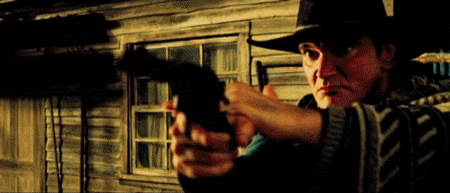
I’m already running out of things to say about this film... It honestly just seems like a drunk or high idea by both Tarantino and Miike. The choice to make the film in English almost made it more absurd. It definitely fits Tarantino’s genre, though I can say I am not as fond of this film as I am other films of his such as Pulp Fiction.
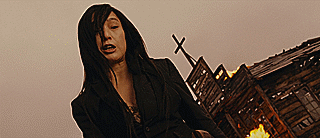
Ben Ten was a fun little twist, though I do think it odd that if she was this powerful, why didn’t she do anything to save her daughter-in-law as she was dying for 30 minutes. Overall, I felt this film handled women terribly. While Ben Ten is shown to be a “cool heroine,” it only seems to appear that way so that Tarantino can get a few more scenes and so that everyone can end up dead. I felt like all the women shown in the film came from some old man’s sexist pipedream. It was weird and honestly kind of demeaning - definitely a film that makes me hate depictions of women written by men in media even more.
One thing that I like to use to decide whether something is putting female character’s in is the “Hawkeye Initiative,” that came to use in comics for showing when art of female characters were overly sexualized. Essentially, artists replace the female character with Hawkeye and see the pose, clothes, and connotations of the final image are being used to over sexualize women. Here’s an example with Mary Jane:
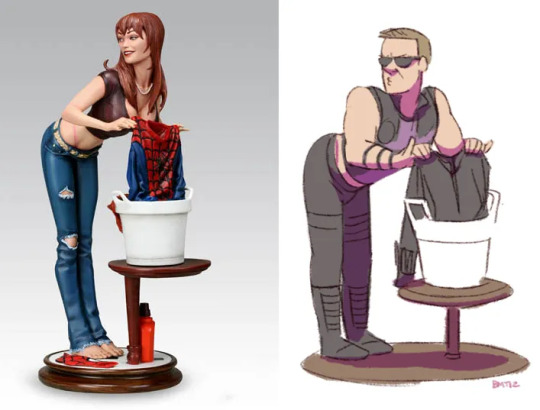
In regards to Sukiyaki Western Django, I’d like everyone to imagine all of the character’s genders as swapped. Now reconsider all the scenes of violence and rape against the women in the film and all the ways that the portrayal of the female characters as passive beings going along with such violence ultimately hurts women. I think if all these scenes were done to men that the audience would react even more grossed out, which is a shame that these gendered differences still exist in film media portrayals. However, I was quite happy that it seemed those who watched the film in class with everyone also found these scenes terrible and audibly reacted as such, which gives me hope that these issues will be solved in the future.

But seriously Dr. Smith, why did you pick this film? I need to know
5 notes
·
View notes
Text
Woah I also love your point on the interior and exterior. I hadn’t noticed that before reading this post. I also felt that the use of nature versus man made environments in the film was interesting as well. Overall, I felt that this film was extremely real and heartfelt.
Sweat Bean
I absolutely loved this movie, it has such a simple but heartfelt story with gorgeous scenery and shots sprinkled throughout the story; ngl I cried for the entire last 30 minutes of this movie.
I think that the main message of this film is that you have to look beyond the surface of things or rather look into something in order to understand and appreciate it; I would describe this film as a story of interiors and exteriors, that are seen in both people and places. This idea is first expressed in the dorayaki itself, as it is only once Tokue uses her An in the dorayaki that Sentarô actually enjoys it.
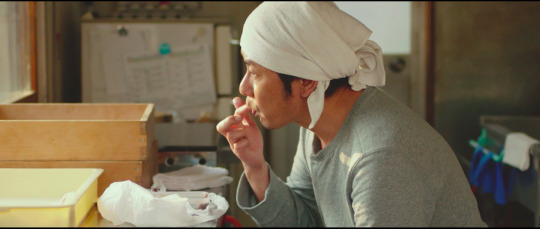
Of course the film then shows that gaining a better understanding of things is not always easy, as Sentarô and Tokue have to rise early and spend hours preparing the An. However, this process is what allows Tokue to impart her ideas of stories to Sentarô even if he doesn’t realise it a first.
The other way that the film explores this idea of interior and exterior is through Tokue herself. Although the only part of her appearance that is physically changed by the leprosy is her hands, she is still discriminated against and literally cast out from society. Yet despite this, she is a very kind and caring person who holds no anger towards the world or society. Similarly, the neighbourhood in which she lives is given negative connotations because of the people living in it, yet it is arguably one of the most scenic locations in the film.
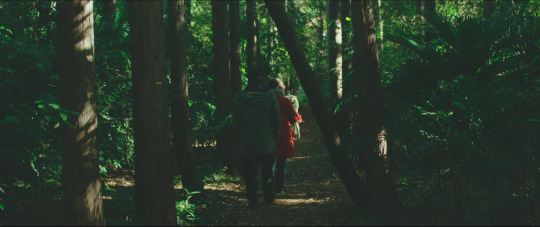
It is interesting, that this is the only place in the film that is dominated by nature rather than by the city. Perhaps this is done to highlight the way Tokue is more in tune with nature than the other characters, as she weaves stories from all parts of nature. I think this also links with her ability to see into people as well, as she did with Sentarô, she empathised with him and saw that he had a story to tell.
Sentarô’s decision to leave the shop and have is own smaller stand is not only a way for him to escape his situation and the interior he was stuck in but also as a way to find his passion for dorayaki and become closer to Tokue. It is significant that his stall is outside, as it shows that he is now free from his burdens and is able to tell his own stories now.
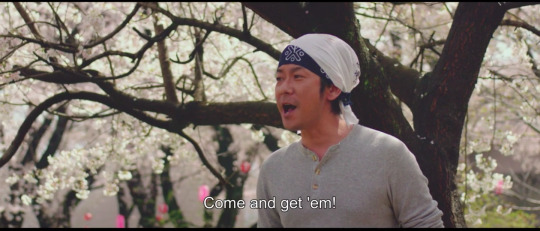
4 notes
·
View notes
Text
Sweet Bean

This movie was very sweet, and very sad. I felt that this movie was a good merger between social activism and an emotional narrative.
The style of the film reminded me of food and cooking documentaries that I watch on Netflix. So much so, that I thought that the film was going to be a food or cooking documentary until about 10-20 minutes into the movie. The characters in the movie seemed so real and tangible that this felt more like a non-fiction film than one of fiction. Tokue especially seemed very based in reality and shows how much research went into this film.
I felt that the scenes around the leper asylum were especially powerful. Going into this movie, I had only ever heard of leprosery and was not as familiar with trials that face those with the illness. It was quite sad and heartbreaking to see how separated they were all kept from society. Because of the film’s use of emotional ties, it is easily seen as a cause to action and awareness about such plights.
One thing that I found interesting in the film was the lack of music. Music is seen only twice within the entire film. 1st when Sentaro is thinking of how happy Tokue is working at the shop. And 2ndly after Tokue’s death when Sentaro thinks back on the time he had with her.
My favorite thing about this film was by far the found family trope. I loved how the main trio of the cast formed their own familial ties despite not being blood related. I feel like in many societies today, especially American society, your family is told to be the unbreakable ties. But, I think we have the ability to make any ties just as strong if not stronger. To quote the often misquoted but ever true, “The blood of the covenant is thicker than the water of the womb.”
3 notes
·
View notes
Text
I loooooove the point you make about the red tape and Passover! That is an interesting connection. I also was reminded of the paper seals used to ward of spirits in China (and probably in other Asian countries as well). Overall, I liked the use of boundaries in this film and thought it was pretty interesting.
Pulse - Kurosawa
For this discussion post I will be discussing Pulse by Kurosawa. I had heard that this movie was scarier than Ringu, but honestly did not scare me that much. I will admit that the glitchy computer ghost were a bit freaky, but not much beyond that. I was waiting for the biggest scare like the stare in Ringu, but it kind of just doesn’t happen in this movie. What you really feel is the haunting presence of the ghost throughout the movie. This feeling of dread caused by the constant presence of the ghosts really added to the atmosphere. It honestly felt like no matter where you went you were always within there sphere of influence. That was one thing I think Kurosawa did better in this film than was done in the Ring. Sadako didn’t seem when you weren’t near a television, but the ghosts in Pulse felt like they were literally everywhere. This feeling of dread is part of Kurosawa’s style, which is enhanced by his framing techniques through the movement of characters and the presence of things not in frame.
The ghosts in combination with the haunting city, as it got emptier and emptier just made the film feel eerier and eerier. The way people faded into nothingness was honestly pretty chilling. The ghosts said that if one was alone and isolated, they were already dead (spiritually), which lead to the characters giving up their will to live and turning into the shadows. The way the city felt so empty honestly reminded me a lot of Shin Megami Tensei, specifically Nocturne. I don’t know if it’s version of Tokyo, after the conception, was inspired by Pulse (considering it was released 2 years later) everyone turns into ghosts, and it feels just as eerie and empty as Pulse’s world at the end.
The main message of pulse was to show how technology effects society as a whole. Kurosawa tries to show a negative aspect of technology, by showing how it literally isolates people. It is through technology that the ghosts are able to enter the human living world and infect people with loneliness. It isolates people to the point that it feels like they no longer exists, thus turning into the shadow.
I initially did not think much about the films message when seeing it the first time, but when looking back on it I feel like I can really resonate with the film’s message. Despite the world being more connected than ever before through social media, it often feels like we are even more isolated than before. I often feel like we can get trapped in the digital world to the point where we are isolated from the real world.
Also I was not sure if the red tape on the door was supposed to be an allusion to the blood painted on the door frame from Passover, as that was what it reminded me of.
I did think the movie went on a bit too long at the end, but I did enjoy the movie overall. I really enjoyed the special effects for the ghosts, as it made them very spooky.
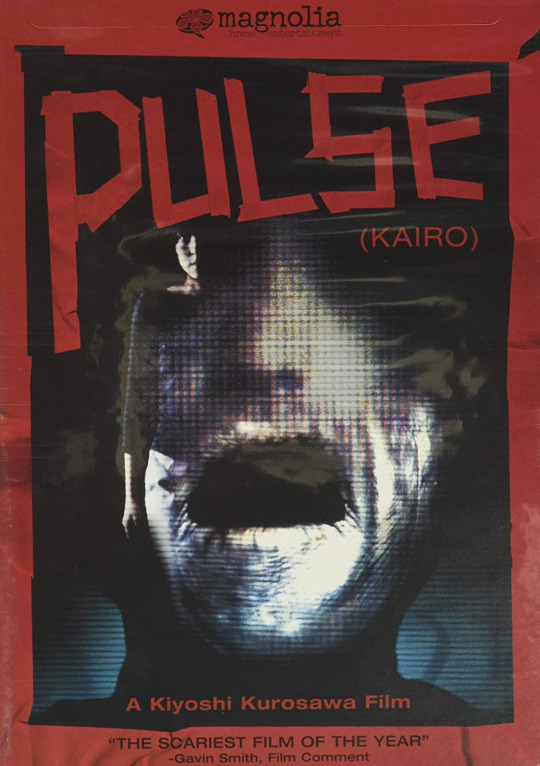
2 notes
·
View notes
Text
Pulse
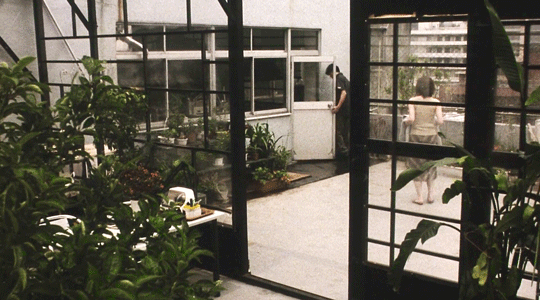
Colors & The Garden
The movie relied heavily on it’s selective use of colors to allow the audience to learn more details about what was occurring with each individual in the film, which later becomes apparent as an even larger symbol having to deal with plant life.
First the movie starts off in a garden, as the protagonists are surrounded by green. In this color they are healthy and undisturbed. However, when the first victim disappears we see a shift in all of the character’s clothing to yellow. Each person has at least some form of a yellow garment or accent that they wear showing that something isn’t quite right - no one is as healthy as they were before and they are showing warning signs of distress much like plants do. After the second victims death, the character’s accent colors shift to orange showing that they are moving forward on the process of becoming dead (much like fall leaves). Anytime a character is on the last scene or day before they go to the forbidden room or they have an experience with the ghosts, they will have red accents. When the lead female protagonist discovers the red taped room but does not enter, she is seen as having red shoes. Meanwhile, her friend who busts in there sports an entire red dress.
Once a character has gotten to this point, there are a few possible ways they could go, depending on how they handle their interaction with the supernatural. In the case of the male botanist, he becomes instantly possessed and only wears dark grey and black until he eventually fades out of existence. Whenever a character is possessed by a spirit in this film they wear dark colors or all black. Yet in the case of the female friend, she goes through a state of panicked behavior which has her dressed in white as if she were an empty shell of herself - the transition from the empty white to the possessed black shows that the spirit has filled her empty shell.
Kawashima is an interesting character for these color analysis points since he at one point wears green on yellow on red to show that he is rapidly changing between phases. Likewise, the computer research lady also shows early hints at being connected to the supernatural through her black and white dotted dress - a direct reference to the dot screensaver shown in the film that also ties to her feelings of emptiness that she believes can only be filled by the supernatural.
Metaphors
Overall, I think that this film is very clear about the message it is trying to convey. Essentially the movie is about how people use the internet as a medium for connection, but this does not actually connect them and instead makes them more lonely. The movies end seems strange, but is it simply trying to show what would occur in this theoretical world where everyone only connects through the medium of technology, leaving behind those who do not join the global rise of the internet. I think this message definitely dates the film, but I can see how at the advent of the internet such messages and ideas most have been very prevalent (and still are to some degree today). While I think the movie paints quite the extreme, it is best to use the internet in moderation and to not miss out on in-person personal relations as I’m sure we all learned during the pandemic.
2 notes
·
View notes
Text
Ring....
Well... that was scary. I thought it would be worse but it was still quite scary...
I don’t really want to look up photos of this movie and accidentally run into frightening screencaps, so no pictures in this blog post. However, because I wasn’t looking at the scary things, I was instead focusing on the use of numbers in the film which ended up being quite interesting.

Numbers:
B4
Let’s start off with the first number in the film: B4. Honestly, this number has two interpretations - one in English and one in Japanese. In English, the hidden meaning is quite clear: B4 = Before. Yet, it isn’t until the end of the movie that the viewer realizes that this is a hint into where the body is since it is found under the building labeled B4. The Japanese meaning takes a bit of thought but, I believe it could be a play on the number “24″. In Japan 24, is considered an unlucky number because it sounds like “two deaths” (ni-shi). 4 will come up a lot in this film since it is the most unlucky number since it sounds like “death.”
54-4226
Breaking the numbers into parts, 54 is the first combo in this sequence. While this is technically a stretch, this could be a multilingual joke on “go die” with 5 = go and 4 = shi.
42 is actually a restricted number in japan since it sounds like “to die” and is never used as the last numbers on a license plate (note that these numbers appear in the middle to make it plausible)
26 is an interesting last number combo to appear since 26 in numerology is typically associated with doomsday. This is because 2+6=8 and 8 is thought to be the number of disaster.
7:01 (some time after seven)
The main protagonist’s time of watching the film and predicted time of death is tied to the number 7 for the number days of the week, which are also the days she has left.
77-3265
At the end of the film, the license plate on the car changes to show this one which is absent of the number 4 - predicting no death is on the horizon. Other than the absence of the number 4, I think the 77 is supposed to bring comfort and good fortune at this point in the film.
6 notes
·
View notes
Text
Seeing the written form of the terms for YenTown was very helpful!!
I also agree that Ryo is not the antagonist of the film, but just another member of the ensemble cast. I thought that this film made me feel as if the ensemble cast of characters were pioneers of a sort. But the film shows that this is partially untrue. the only difference between the main cast and others is that they are being filmed and their stories are being told. Anyone could be them or become them with the same situation and luck. I definitely enjoyed the ensemble cast for this film and thought that it was a successful choice for this film.
Swallowtail Butterfly – スワロウテイル
A wonderful mess, that’s how I could describe this film. A world that is dirty, cruel, unforgiving, and beautiful all the same.
The movie went on for quite a bit, but it used all of that time pretty wisely to really flesh out the world they were trying to depict, a world showcasing a wide breadth of humanity, extending past nationality, race, class, gender, and language. Really, characters were speaking Japanese, English, Mandarin, or Cantonese, so I’m very impressed with the dialogue and how it was handled here. Language is played around with quite a bit as well, in particular with the name of the city and the immigrants, the city has the nickname of Yen Town (円都, en to), and the immigrants are referred to with a loose homophone Yen Thieves (円盗, en tou) which is anglicized as “Yentown” in dialogue and subtitles. Many different characters clung and clashed with each other in this bizarre but inspiring plot, and if this film did anything well, I think it allowed every character to have their chance to shine.
It's like multiple genres are belnding together to tell this tale. Characters start off mostly supporting one another until they all gain a path to fortune that allows them to realize their various dreams, but this comes at the cost of their solidarity with one another. With Glico we have a distinct musical element, with Ryo Ranki and Fei Hong we have a crime drama, and with Ageha we have something of a social realist journey. While Ryo certainly has some antagonistic qualities, I couldn’t really pin him as the villain, just another character in the film, and in a way the protagonist of his own story, just as any of the central characters were. Everyone is finding their own way, living the lives they want to live the way they want to live them.

One thing that was always shrouded in ambiguity was Ageha and her actual heritage, we never find out if she was Japanese or an Asian immigrant, and this was certainly by design. Her actual bloodline is not important here, she is from Yentown, that is her home and something she learns to hold onto with pride. It’s a bold statement that stands against the stubborn ideology of Japan surrounding racial purity and only valuing a specific birthplace. She manages to find a path forward in life that is fulfilling for herself and allows her to hold those she cares for close to her, and it has nothing to do with her race or nationality, but the resolve she gains from her experiences. She was forced to confront her own set of issues on her own and managed to help the people close to her along the way. Despite how wild the events got, I think her growth and resolve was great to witness, and she ended up being a wonderful protagonist.
In the end the animosity anyone held has vanished, and we were left to wonder how this world might progress in the future, as they left some plotlines up in the air. I don’t think it was necessary to know Ryo Ranki’s fate, or the fate of the other Yentowns. We already saw the most important parts of these characters and what the film really had to say about them, that is their journey, not their destination.
9 notes
·
View notes
Text
Swallowtail Butterfly
This film was certainly a 2 and a half hour rollercoaster ride. I was very impressed by the usage of 3 languages within the same film, I felt that this element added a lot to the discussion of nationality and origin within Japan, as well as addressing groups of chosen belonging. All in all, I rather liked this chaotic film. I doubt it will be one of my favorites but it was certainly entertaining.

I liked the use of color in this film. Though it did not seem as orchestrated as some of the previous films we watched, it was still used for some of the more major characters and scenes throughout the film. One example is Glico’s red dress. While in theater, primary colors are often used to denote main characters - in this film they are used to show ties to either prostitution or gangs.
I loved seeing the one druggie prostitute lady who would randomly appear and change the entire course of the film through her tiny actions. *cough* *cough* could it be the BUTTERFLY EFFECT?! Yes, more than likely, I think this woman’s whole purpose in the plot.

I enjoyed the use of color correction on this film. The over-correction, leading to over saturation in many instances gave the film a vibrant touch that added to the aesthetics of the culture the people of Yentown had created for themselves.
While it was sad to see Hoi beaten to death (I actually felt very distraught during this scene - the image of police officers willingly and purposefully beating someone to death was horrifying) I did like the symmetry and cyclical nature of starting and ending the film with a corpse. The first corpse is accompanied by an onslaught of emotional mourners surrounding the body, but who only tell lies about the corpse. This is distinctly reversed in the final body scene where everyone remains stoic, but tells the truth about the body.
2 notes
·
View notes
Text
Current Film Ranking
I just put together a list of my preferences for the films we have watched in class thus far! Enjoy my hot take:

3 notes
·
View notes
Text
I completely forgot to talk about Nishi’s sunglasses, which I think is ironic because I heavily analyzed the gaze in all of the paintings in this film but forgot the most obvious use of “the gaze.”
I like your thought process for analyzing when he was having his vision “clouded” or “deluded” vs when he was really seeing what was going on. I think it was very insightful, though I don’t know if I agree that the glasses are tied to him feeling sad. I think it is closer to Nishi idealizing the world around him - particularly his wife’s final days, his friend’s suicidal tendencies, and his lost coworker. But this is just my take on it from what I saw.
Hanabi - Takeshi Kitano
For this discussion post I will be discussing the movie Hanabi (Fireworks) by Takeshi Kitano. Hanabi was an interesting movie that revolved around ex-police officer Nishi, as he struggles to accept the fact that his wife is dying, the trauma of his comrades dying, and his misadventures in the criminal underworld.
The first thing I noticed in the movie was the fact that Nishi was almost always wearing sunglasses. He would even be wearing them inside sometimes, which is just really weird. My guess is that they had some kind of symbolic meaning, perhaps when he is wearing his sunglasses he is putting on a persona or is hiding his true self.
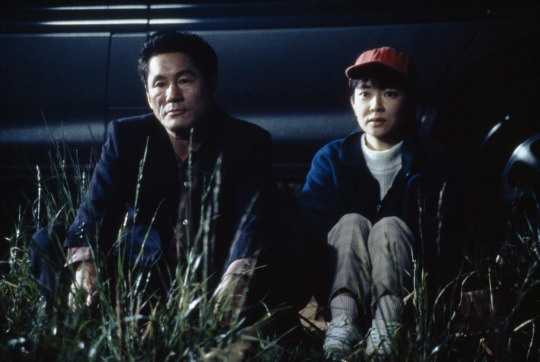
You can always feel this kind of weird dissonance when watching the relationship between Nishi and his wife. The fact that he planned this trip and spent a bunch of time doing things with her shows that he cares for and loves his wife, but on the other hand you can clearly see the distance between Nishi and his wife. This culminates in the scene where it is implied that he shoots his wife and himself with the last two bullets in the revolver he got from the yakuza thug. You can tell something bad was going to happen for two reasons, one was the suicide painting that the guy in the wheelchair drew, and the other was that he was wearing sunglasses while spending time for his wife for the first time. When looking back through the film I checked to see where he was wearing his sunglasses, and he never wears them with his wife until that day, so you knew something was up. This really built up the tension in a subtle way, and since the day goes on for so long it just prolongs this uneasy feeling.

You also get this feeling when he is talking to his old coworkers, as the interactions with them just feel really awkward. Things must have not been the same after the death of Tanaka, and it broke the social dynamic between Nishi and the crew. The dissonance may also be due to Nishi’s violent streak, where they mention being scared of him when he lost his temper and unloaded his gun into a dead body. In the past when he’s at the sushi restaurant with one of his coworkers, Nishi still has the glasses off, so he is still his true self at this point. You can tell by the fact that his interactions still seem genuine at this point.

Nishi also does not were sunglasses when he is preparing for and carrying out the bank robbery, and when he confronts the yakuza for the final time. I think this is because the excitement and thrill of it helped him to feel alive and brought him out of his sadness and disillusionment. This and the time spent with his wife were the only times he felt like himself, so they show him without sunglasses.
The fact that no one comments on Nishi wearing sunglasses pretty much all the time leads me to believe they are symbolic, and that Nishi isn’t actually really wearing any literal sunglasses. They are just a way that Kitano communicates to the audience that Nishi isn’t his true self at that moment, and that he is putting on a persona.
I also really liked the scene where the guy comments on Nishi’s wife watering dead flowers since his quote, “It’s no use watering dead flowers”, pretty much sums up the problem Nishi found himself in with his wife. That’s probably why it made Nishi so mad, to the point that he beat the guy up for saying it.
There were also all the paintings done by the guy in the wheelchair, which some were obvious representations of what was going on in the movie, others were predictions of what would happen (such as with the suicide painting), and there were others where I was not sure what they meant. There were a lot of paintings of ‘flower animals’, I’m not sure if they were supposed to mean something? I’m not super familiar with flowers and what they represent, so this part kind of just went over my head.
As for my thoughts on the film, it was honestly very interesting. I was constantly on the edge of my seat, trying to figure out Nishi as a character, understand the symbolism, and anticipate what crazy thing would happen next. The soundtrack for this movie was great, and had this kind of jazzy feel to it. Nishi was also just pretty cool, the fact that he was able to take down the thugs with no effort was so awesome.

5 notes
·
View notes
Text
Hana-bi
First off, this movie comes with an amazing score made by the one of the coolest instrumental composers, Joe Hisaishi. When the music started playing his style was instantly recognizable to me and it really made the movie even more emotional than it already was.
There is a lot of very detailed symbolism within the movie to unpack, but I will focus on some of the instances that I thought were the most interesting or impactful.
Overall, I loved this movie a lot. It is also going to be one of my favorite films for this class.

Taking Away the Gaze
This film contains a lot of paintings on the walls of the set, which was clearly a thought out choice by the director. All of the paintings that make up the walls in the film either have eyes and gazes that confront the actors or audience or they have elements that look like eyes - such as the sunflowers. Yet, when Horibe begins to create art, he begins with a very unique approach that seems almost subconscious or at least somewhat psychological. Whenever Horibe paints or draws creatures or people with eyes they are either closed, facing away, or have their eye or head replaced by flowers. In this manner, Horibe has stripped all of his subject of their ability to gaze. To me, this has a couple of interpretations within the context of the film. One of these interpretations is that Horibe feels unseen, that no one is actually able to see or understand what he is going through. Another is that he is purposefully taking away people’s gazes so that they are no longer able to see or understand him. There are also other possible interpretations, so feel free to comment if you have a better one!
Another interesting note on Horibe’s art, are the references to George Serat and his painting Sunday in the Park. The dot texture (called stippling) that Horibe uses was made famous by the painter George Serat who is famous for painting scenes of public social gatherings. I believe that the reference to Serat’s style is supposed to be taken as irony since Horibe’s paintings all have a sense of loneliness imbued within them.

Age Regression and Replacement
The viewer is first introduced to Nishi’s wife in relation to the couple’s dead daughter who also suffered from Leukemia. As the movie progresses, we see a lot of signs that it almost appears that a child is still living in the couple’s home such as the tricycle in the doorway. Yet, with the daughter dead, there is no child to be found. Instead, the wife has become overly childlike so that she can replace their dead daughter.
I found the wife’s acting as well as the childish costume’s picked for her to be very well done. This topic could become very concerning especially with the issue of some viewers infantilizing Asian women. However, I thought that this movie portrayed the wife’s dilemma in a respectful manner that made certain there was no room for sexualization.
As the movie draws to a close, there are several instances where the wife begins to realize she is not a child, leading up to the ending scene where the wife has fully regained her sense of self as she watches a stand in for her dead daughter play on the beach. With her sense of self regained, the couple can end their story together in hopes of joining their dead daughter.

It’s no use...
The most impactful scene in the movie was the scene where the wife puts dead wildflowers in a jar and waters them. The spectator comments that “It’s no use watering dead flowers.” To me, this scene represented a microcosm of the film’s main message as a whole. The dead flowers represent the wife - a terminally ill patient with a death date rapidly closing in. To say that there is no point in allowing “dead flowers” water, is essentially saying that there is no use in trying to fulfill the last moments of one’s life with as much joy as possible. While this won’t change the outcome - they will still die - I believe that it is far from futile.

0 notes
Text
I also had some thoughts about the last boxing scene. To me, I got the feeling that the cab driver and the people in the park viewed the fighting match as “entertainment” instead of violence. I felt like there was a veil of “otherness” about this scene where the father and son were viewed as outsiders whose actions had no actual consequences despite the fact that Sugihara gets beat more than even a boxing match would. This felt similar to Song Il’s death where the he is cradled by the only other “outsider” in the scene as he bleeds to death while no one does anything to help him.
Go
I loved this movie!! It was such a fun watch and I also felt it presented the absurdity of the discrimination that “non-Japanese” populations face in Japan, and did not really hold back in making its message clear. I thought it was going to be a Romeo and Juliet adaptation, but was very pleased with what it was actually about.

Being a Zainichi
The issue of identity and nationality are the main focus of this film, despite Sugihara occasionally reminding us that this is a love story. Sugihara’s status as a Zainichi affects everything he does and almost places limits on what he can and can’t do. He says he has dreams of becoming a doctor or a lawyer, but he also immediately says those are impossible when talking with Sakurai. He and Jong-Il talk about college and reaching high places in the workforce, but Sugihara just simply doesn’t believe in it because he feels he’s not in a position where those dreams are attainable. He also attributes his inclination to fight and to be a delinquent as attributes of being a Zainichi.
However, Sugihara eventually realizes that his status within Japanese society does not represent something tangible, or rather, that the box he has been put into doesn’t define him or have any real meaning in the grand scheme of things. He breaks himself out of this box in many different ways, sometimes without realizing it. For example, when his old classmate asks him to help get revenge for Jong-Il, Sugihara refuses because violence (something he associates with being Zainichi) is not necessary and is just a mindless, unnecessary choice to make. He also decides to go to college, which he previously saw no point in. The only thing holding him back from doing all of these things was the internal prejudices he had towards himself, and by the end of the film, he was able to overcome these obstacles.
I also liked that he had a lot of other characteristics than just being violent and boisterous. He was so focused on being a Zainichi that he didn’t really focus on how he enjoyed reading and learning, or how he liked music and was really excited to go to the opera. Considering how he was reading at a club, these characteristics were pretty obvious to the audience, so it was really nice to see him decide to go to college. (It was also nice to see him decide to pursue higher education because Jong-Il believed that he could… This is slightly off topic, but I gasped when he was stabbed and was very upset.)
Being a Boxing Referee
My favorite scene is probably when Sugihara gets horribly beaten up by his father near the end of the film. However it is not because of the beating, but instead the pure enthusiasm of the taxi driver going above and beyond to celebrate the father’s win.
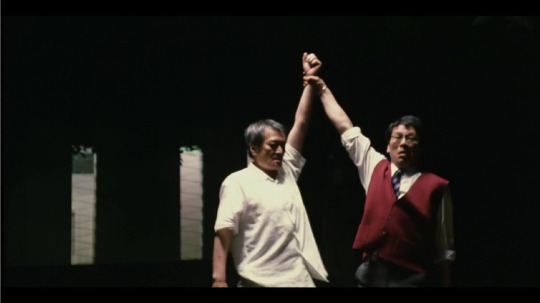

It’s just so funny, I mean look at him. I love how excited he is that his generation’s representative was able to just overpower the younger generation.
To be more analytical, if we look at it from a modern perspective, the normalcy of physical abuse towards children as punishment really stands out. However, from the point of view of these particular characters, boxing and fighting have been how they come to an understanding. Even though the father beats his son—and makes the point that you have to do whatever you can to win—he understands that Sugihara may have a point in regards to the discrimination they face. They both consider each other’s perspectives and recognize the importance of both, bringing them closer together. It was a nice moment if you overlook the blood.
5 notes
·
View notes
Text
Go
This was definitely the most enjoyable movie we have watched thus far in class. I loved the film. I felt very invested in Sugihara’s development throughout the film and was genuinely excited to see what would happen next. 10/10 going to be one of my favorite films from this course.

The Cult of Catcher in the Rye
The novel, Catcher in the Rye was not only a huge success in America but became hugely popular in Japan as well as a classic novel for high school education. While Sugihara isn’t actually reading the novel during the film, the mention of it does hint towards the final resolution of the plot. In the novel, the general arc of the plot revolves around the protagonist realizing that he has to let go of his childhood and move on into adulthood. Just like in the novel, Sugihara comes to the realization that he has to make a decision about his future and chooses to study and go to college.
Lighting in Confrontations
During the scene where Sugihara tells Tsubaki his real nationality and name, Sugihara is seen casting a dark shadow over most of Tsubaki’s face as he becomes a dark silhouette against the light from the window. Once he tells Tsubaki this, Sugihara faces the light since he no longer has anything to hide. The dramatic lighting in this scene not only heightens the emotion of the climax, but also lets the viewer see visually the feeling of coming into the light after hiding.
Crossing Boarders
My favorite detail with the set of this film is the gate to the playground that Sugihara and Tsubaki jump over on their date. The first time the boarder of the gate is present, both kids jump over it without thinking since at this point boarders and nationalities hold no importance to them. They are just kids being kids. Yet, in the final scene once both characters have “grown up into adults”, Tsubaki has already crossed the gate and makes no move to come back over the gate upon Sugihara’s arrival. Sugihara, on the other hand, doesn’t cross the boarder of the gate. Instead, he yells across until he confirms what Tsubaki thinks his nationality is. With this confirmed, he makes a show of crossing the boarder - this show of being able to exist in both worlds displays what Sugihara thinks of himself in regards to his nationality.
2 notes
·
View notes
Text
I liked that you pointed out the Seven Samurai references! I completely missed those. As someone who hasn’t seen westerns nor spaghetti westerns, I felt like some of this movie was lost on me, but I was still able to appreciate the comedy and absurdity of the film.
Tampopo
Tampopo was a fun watch for me, but I’m glad we did not have to watch it with the rest of the class because there were some saucy bits in there I would not feel comfortable watching with a group of 20+ people. Tampopo is a comedy movie about a struggling widow trying to perfect the perfect ramen recipe in order to build a successful shop, and with how boring that plot sounds, it was crazy to see what Itami Juzo did to keep us on our seats.
Initial Reactions
For starters, it was interesting to see a young Ken Watanabe playing the role of Gun in the movie. It seems that in American cinema, there isn’t a large number of Japanese/Japanese-American superstars in the acting field, and so seeing Ken Watanabe made me feel glad that someone was able to break through that mold.

I also liked the irony in the beginning of the movie, where the “Man in the Suit” (for lack of a better term) chastises others for eating loud foods during a movie, despite the fact that the movie we’re about to watch is about ramen, a notoriously slurpy food. This character also has some of the best and strangest scenes, although I do hold some reservations about his morality, as the weird oyster scene with the young girl seems like he’s grooming her, which was kind of disgusting.
An interesting part of the movie that hopefully we might see in subsequent films is the inspiration it took from other films we have already seen. This is most notable in the formation of a ragtag ensemble of ramen experts being Seven Samurai-esque, and the whole film having a Western feel to it, with Goro’s cowboy outfit being the focal point of this. This really reinforces the impact of the old films we watched, and I much enjoyed it.
Themes/Analysis
To be completely honest, I couldn’t really pinpoint any themes that I felt were worth writing about. The determination of Tampopo to be the very best ramen cook (that no one ever was) might be the clearest theme to look at, but I feel as if analysis about that has been written into the ground already, as that’s a central plotline in so many movies. However, I feel something that might be worth writing about for this movie might be the that we don’t need themes to enjoy films, especially comedies. I didn’t go watch Ghostbustersto learn a deep lesson, and I don’t think Tampopo needs this level of analysis either; it’s just a fun movie with unique shots and stories that make it enjoyable to watch.

Final Thoughts
Tampopo is definitely up there in my rankings of movies for this class, despite the fact that it didn’t drive home a central message or have an overarching theme. It was a fun watch with wacky characters, even wackier hijinks, and beautiful food that made me hungry for some ramen.
6 notes
·
View notes